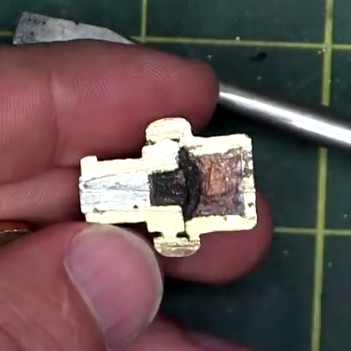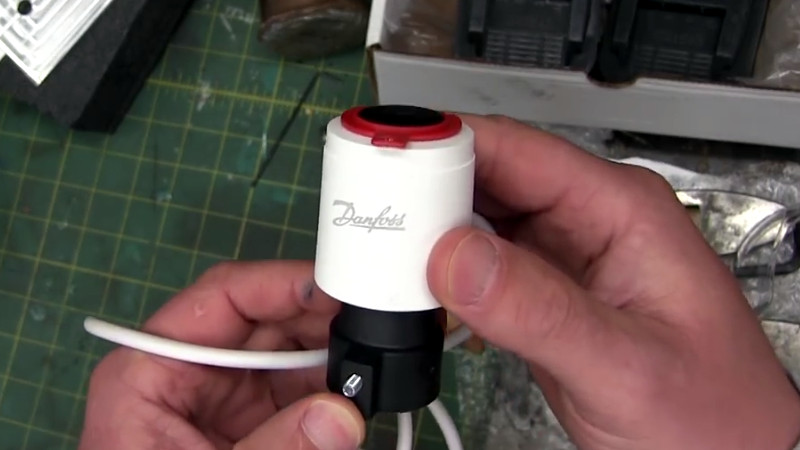We’d wager most readers aren’t intimately acquainted with wax motors. In fact, a good deal of you have probably never heard of them, let alone used one in a project. Which isn’t exactly surprising, as they’re very niche and rarely used outside of HVAC systems and some appliances. But they’re fascinating devices, and once you’ve seen how they work, you might just figure out an application for one.
 [AvE] recently did a complete teardown on a typical wax motor, going as far as cutting the thing in half to show the inner workings. Now we’ve seen some readers commenting that everyone’s favorite foul-mouthed destroyer of consumer goods has lost his edge, that his newer videos are more about goofing off than anything. Well we can’t necessarily defend his signature linguistic repertoire, but we can confidently say this video does an excellent job of explaining these little-known gadgets.
[AvE] recently did a complete teardown on a typical wax motor, going as far as cutting the thing in half to show the inner workings. Now we’ve seen some readers commenting that everyone’s favorite foul-mouthed destroyer of consumer goods has lost his edge, that his newer videos are more about goofing off than anything. Well we can’t necessarily defend his signature linguistic repertoire, but we can confidently say this video does an excellent job of explaining these little-known gadgets.
The short version is that a wax motor, which is really a linear actuator, operates on the principle that wax expands when it melts. If a solid block of wax is placed in a cylinder, it can push on a piston during the phase change from solid to liquid. As the liquid wax resists compression, the wax motor has an exceptionally high output force for such a small device. The downside is, the stroke length is usually rather short: for the one [AvE] demonstrates, it’s on the order of 2 mm.
By turning heat directly into mechanical energy, wax motors are often used to open valves and vents when they’ve reached a specific temperature. The common automotive engine thermostat is a classic example of a wax motor, and they’re commonly found inside of dishwashers as a way to open the soap dispenser at the proper time during the cycle.
This actually isn’t the first time we’ve featured an in-depth look at wax motors, but [AvE] actually cutting this one in half combined with the fact that the video doesn’t look like it was filmed on a 1980’s camera makes it worth revisiting the subject. Who is going to build a wax motor power device for the Power Harvesting Challenge in the 2018 Hackaday Prize?

















“they’re very niche and rarely used outside of HVAC systems and some appliances”
Most, if not all water cooled cars use the wax motor in the thermostatic valve.
Also, they are very common in home heating (in the UK at least, with water based radiators).
I guess the quote is true for ‘self heating’ types though, as per the video.
We can get these for radiators, usually for smart-heating type systems.
I’m guessing you didn’t read the whole of the post, where their use in automotive engines was mentioned.
But more to the point, those aren’t a particularly useful application of wax motors for us as hackers/makers/etc. These types, like pulled out of appliances, are much easier to reuse.
Fair play – I had already watched the video, so mistakenly skimmed the article.
It was mentioned in the video as well
The wax “solenoid” in my multi-port fuel injection Suzuki Sidekick (R.I.P) was part of the emissions system, it directed a small stream of coolant to warm up the intake when needed. I was surprised to learn that something made out of “wax” was able to reform when cooled and worked reliably for 18 years (or more).
the automatic choke on most scooters uses them too
They are also used on some small engines to deactivate the choke mechanism for cold starts. Scooters and such.
We have the piston type in my mother’s greenhouse to open roof vents
https://suchandsuchfarms.files.wordpress.com/2013/02/img_5838.jpg
You can see there there is a ton of leverage going on to compensate for the short throw and you can get an idea of the force they have to lift such large windows up
Beat me to it :)
This is a very common usage here in the UK.
The force exerted is more than enough to bend the mechanics far beyond any hope of repair if the window is prevented from opening for any reason.
Say… Laying the roof panels face down after dismantling a 10×8 wooden greenhouse and going to lunch…
Wrap a Nichrome coil around several of those and make a robot Sloth.
EAHS can have a pretty long stroke for a wax motor.
https://flintbox.com/public/project/29416
Another use is to lock the door in your washing machine. That’s how I discovered that turning it off for a minute allows to open the door and add more clothes when you find something you forgot to add :)
Not only locking the doors – I got a second one in my washing machine to switch between “aqua spray” and “pump-out” function with just one pump in a circuit.
the washing machine locks I’ve looked at was a bimetallic strip
I’ve seen a bimetallic strip used in the dishwasher soap dispenser as well.
My 1986 Honda Spree scooter has one. It turns the choke off and is powered by the alternator so when you start the scooter, the choke is on, but as it runs it gradually turns off. It is also slow to return to the closed position, for hot starts. Honda calls it the Bystarter for some reason.
Nearly every scooter with carburetor has one – it’s called Auto Choke. I am not sure if it’s actually wax based, but definitely looks like it.
I recently replaced the thermostat on my Smart car and for whatever reason, they have used an electrically heated thermostat instead of one that operates from coolant temperature.
This allows them to charge £150 for it instead of the £4 water operated one that I replaced it with. Working fine after over 6 months of use, one has to wonder where these car manufacturers get their ideas from.
I had to look this one up since an electrically heated thermostat valve sounds like some kind of nonlinear systems class project. I could be quite wrong, but It seems that the thermostat itself is traditional though there’s a temperature sensor on top of it (that can be reused), and they’re sold by many places as a single unit for about the price you quote.
Instructions here: https://www.evilution.co.uk/Engine/450_thermostat_valve_change.htm
that valve linked is indeed a traditional thermostat and temp sensor in a housing. however plenty cars now have an electrically assisted traditional thermostat. so there is a small heater inside the wax part. from what I have gathered, the idea is car cooling systems are made smaller to get the warm up time faster. the problem is if you were to ,say, start the car from cold and start lugging weight up a hill you could”beat” the thermostat and overheat the engine. so when full throttle is used on a cold engine the car starts to pre-emptively heat the thermostat. BMW and GM(vauxhall here) seem to use these in all their new cars, and no doubt some other manufacturers do too.
they are also a common failure point, tho their price is rapidly coming down.
Interesting, I didn’t know factory cars were using these. I knew some race cars used these to allow for a variable thermostat opening point – if the engine is running too hot, you can switch on the wax heater to effectively lower the thermostat’s opening temperature. This slightly overcools the engine at some points and gives you some more thermal headroom.
Your link show s 450 thermostat, not a 451. The 450 is a quite normal wax thermostat but the 451 (CDI) has a power feed to heat the wax.
Ironically one for a Corvette is just $10 to $27 depending on where you get it.
Remember that Smart cars are Mercedes-Benz products. ‘Nuf said.
Not so smart in other words. Hahaha :)
I imagine there’s a great deal on wax composition to go with this.
A solar panel sun tracker application was hinted at. I’m sure that they already exist, a closed gas system, if I recall correctly. This wax motor is interesting to know about, but at the moment I can’t see where it would be a practical solution for any project. How ever “vacuum” motors are more interesting. They use a free and ever present power source
The Honeywell (Sparco automix) tempering valve uses the wax motor , It blends hot and cold water to give a preset, but adjustable warm water out. A fascinating use for this valve is to use it as a diverter. For example, cold water flowing in a pipe followed immediately by hot water or vice versa,((I think we’ve all experienced that while taking a shower) , If that stream is fed to the output port of the mixing valve, it will separate the hot water from the cold and divert them out the different input ports.
ave knows what he is talking about!
Hah, sure, if you can get him to be serious for 500 ms you might get something of value.
80’s GM 4wd trucks used 12v to heat the wax and engage the front axle (4wd) – It didn’t work so well in cold weather (when you need 4wd….) so it was replaced with an electric motor around 1993…
Engine thermostats are almost always a wax motor.
Thermostatic mixing values use these. TMVs are heavily used in building construction – especially hospitals and aged care facilities, where you need to set a constant water temperature from the tap. Such facilities also use ‘hot loop’ water systems so there’s none of that unpleasant cold water before the warm water starts flowing.
Check out sulasindustries.com for a mighty thermal solar tracker, it’s basically a wax motor providing up to 3,000 ft/lb. of rotary torque.